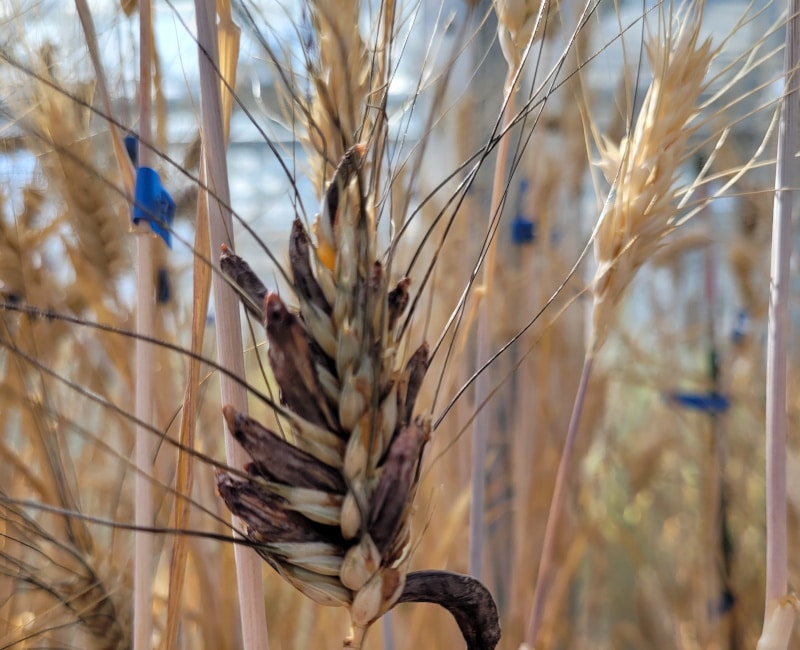A year after University of Saskatchewan researchers played a key role in decoding the genome for the bread wheat variety Chinese Spring, they’ve done it again — this time in durum.
USask researchers played a key role in an international consortium that has sequenced the entire genome of durum wheat—the source of semolina for pasta, a food staple for the world’s population, according to an article published today in Nature Genetics.
“This ground-breaking work will lead to new standards for durum breeding and safety of durum-derived products, paving the way for production of durum wheat varieties better adapted to climate challenges, with higher yields, enhanced nutritional quality, and improved sustainability,” said Luigi Cattivelli of Italy’s Council for Agricultural Research and Economics (CREA).
In an exciting discovery, USask plant breeder Curtis Pozniak, along with University of Alberta scientists Gregory Taylor and Neil Harris, identified the gene in durum wheat responsible for accumulation of cadmium, a toxic heavy metal found in many soils. The USask team discovered how to significantly reduce cadmium levels in durum grain, ensuring the safety and nutritional value of the grain through selective breeding.
The durum wheat genome is four times as large as the human genome. The team has for the first time assembled the complete genome of the high-quality Svevo variety.
“We can now examine the genes, their order and structure to assemble a blueprint that will provide an opportunity to understand how the genes work and communicate with one another,” said Pozniak. “With this blueprint, we can now work quickly to identify genes that are responsible for the traits we select for in our breeding programs such as yield, disease resistance, and nutritional properties.”
The research involved more than 60 scientists from seven countries. The work was co-ordinated by Cattivelli and included corresponding authors Pozniak of USask and Klaus Mayer of the Helmholtz Zentrum München (Germany), as well as researchers Aldo Ceriotti and Luciano Milanesi of Italy’s national research council CNR and Roberto Tuberosa of the University of Bologna (Italy).
Durum wheat is mainly cultivated in Canada, Europe, United States, and South Asia, and remains a key crop for small farms in North and East Africa, as well as the Middle East.
“This is an exciting development for durum farmers as it will mean wheat breeders will be able to produce varieties with improved yields and resistance to disease, pests, and environmental stressors quicker than before,” said Laura Reiter, Chair of the Saskatchewan Wheat Development Commission board of directors, who farms near Radisson, Saskatchewan.
“The investment in this research on behalf of Saskatchewan durum farmers is expected to lead to productivity gains and will allow them to capture opportunities in markets that desire the high-quality grain that Saskatchewan farmers produce,” she said.
Durum wheat, mainly used as the raw material for pasta and couscous production, evolved from wild emmer wheat and was established as a prominent crop roughly 1,500 to 2,000 years ago in the Mediterranean area.
The scientists compared the durum wheat sequence to its wild relative and were able to reveal genes that humans have been selecting over the centuries. The team uncovered a loss of genomic diversity in durum wheat compared to its wild wheat relative, and they’ve been able to map these areas of loss and precisely recover beneficial genes lost during centuries of breeding.
“We can now see the distinct DNA signatures that have been so critical to the evolution and breeding of durum wheat, enabling us to understand which combination of genes is driving a particular signature and to maintain those target areas of the genome for future breeding improvement,” said Marco Maccaferri, lead author of the manuscript.
As pasta is a staple for the world’s population, industries are asking for more, safer, and higher-quality durum wheat.
“Having this durum wheat high-quality genome sequence enables us to better understand the genetics of gluten proteins and the factors that control the nutritional properties of semolina. This will help to improve pasta quality traits,” said Italian scientist Ceriotti.











